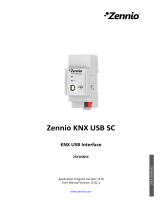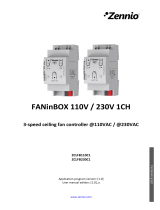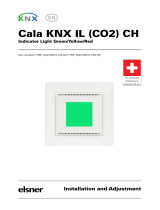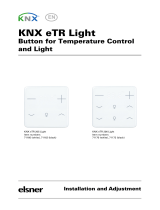Page is loading ...

KLIC-MITT
http://www.zennio.com Technical Support: http://support.zennio.com
2
CONTENTS
Contents ........................................................................................................................................ 2
Document Updates ....................................................................................................................... 3
1 Introduction .......................................................................................................................... 4
1.1 KILC-MITT ......................................................................................................................... 4
1.2 Installation ........................................................................................................................ 5
1.3 Start-Up and Power Loss .................................................................................................. 6
2 Configuration......................................................................................................................... 7
2.1 General ............................................................................................................................. 7
2.2 Inputs ............................................................................................................................... 9
2.2.1 Binary Input .............................................................................................................. 9
2.2.2 Temperature Probe ................................................................................................ 10
2.2.3 Motion Detector .................................................................................................... 10
2.3 Logic Functions ............................................................................................................... 11
2.4 AC Gateway .................................................................................................................... 12
2.4.1 Configuration ......................................................................................................... 12
2.4.2 Fan .......................................................................................................................... 15
2.4.3 Flaps ....................................................................................................................... 18
2.4.4 Initial Configuration ............................................................................................... 21
2.4.5 Scenes .................................................................................................................... 22
2.4.6 Error Handling ........................................................................................................ 23
ANNEX I. Communication Objects............................................................................................... 25

KLIC-MITT
http://www.zennio.com Technical Support: http://support.zennio.com
4
1 INTRODUCTION
1.1 KILC-MITT
KLIC-MITT from Zennio is a gateway that provides full-duplex communication between
the KNX home automation system and Mitsubishi Electric air-conditioning systems
through the IT Terminal interface provided by the latter.
Because of this bidirectional communication, the air conditioning system can be
controlled from the home automation system in the same manner as it is through its
own controls. Moreover, the actual status of the unit can be monitored and periodically
sent to the KNX bus to inform other devices.
The most outstanding features of KLIC-MITT are:
Bidirectional control of Mitsubishi Electric HVAC units through their IT
Terminal connector (CN105/CN92).
Control of the main functions of the A/C unit: On/Off, temperature, mode of
operation, fan speed, position of the flaps, etc.
Error management to handle specific error codes from the A/C unit itself as
well as any communication issues that may arise.
Up to five scenes.
Three analogue-digital inputs, for the connection of temperature probes,
motion detectors or binary pushbuttons or switches.
10 customisable, multi-operation logic functions.
Heartbeat or periodical “still-alive” notification.

KLIC-MITT
http://www.zennio.com Technical Support: http://support.zennio.com
5
1.2 INSTALLATION
Figure 1. Element scheme
KLIC-MITT connects to the KNX bus via the corresponding built-in terminal (5). Once
the device is provided with power from the KNX bus, both the physical address and the
KLIC-MITT application program can be downloaded.
This device does not need any external power as it is entirely powered through the
KNX bus.
The remaining elements are described next.
Prog./Test button (2): a short press on this button will set the device into the
programming mode, making the associated LED (1) light in red.
Note: if this button is held while plugging the device into the KNX bus, the
device will enter into safe mode. The LED will blink in red every 0.5 seconds
Analogue-Digital Inputs (3): input ports for the stripped cables of external
elements such as switches, motion detectors, temperature probes, etc..
Communication cable (4): cable with a CN105/CN92 connector that will
connect KLIC-MITT to the A/C unit. The other end of the cable, therefore, is
intended to be connected to the IT Terminal connector in the PCB board of
the internal unit.
1. Prog./Test LED indicator
2. Prog./Test button
3. Analogue/digital inputs
4. IT Terminal connection cable.
5. KNX connector

KLIC-MITT
http://www.zennio.com Technical Support: http://support.zennio.com
6
Figure 2. Connecting KLIC-MITT to the A/C unit
Important: if intending to control the A/C unit both through its incorporated wired
remote control and through KLIC-MITT, it must be taken into account that orders sent
from the wired control will have a higher priority than those sent through KLIC-MITT. In
addition, certain parameterisations made in the device can be ignored.
For detailed information about the technical features of KLIC-MITT, as well as on
security and installation procedures, please refer to the device Datasheet, bundled in
the device packaging and also available at http://www.zennio.com.
1.3 START-UP AND POWER LOSS
Depending on the configuration, some specific actions will be performed during the
device start-up. The integrator may set up an initial status to be sent to the A/C unit
after the bus power recovery, and whether certain objects should be sent to the bus
after the power recovery, as described in later sections.
On the other hand, when a bus power failure takes place, the device will interrupt any
pending actions, and will save its state so it can be recovered once the power supply is
restored.

KLIC-MITT
http://www.zennio.com Technical Support: http://support.zennio.com
7
2 CONFIGURATION
2.1 GENERAL
The general configuration of the device consists in enabling the specific functionalities
that will be required during normal operation:
Heartbeat or periodical “still-alive” notification.
Inputs: see section 2.2.
Logic functions: see section 2.3.
AC gateway: see section 2.4.
The latter entails all functions specific to KLIC-MITT, i.e., all the functions related to
interfacing with the A/C unit and to the management of the climate control system.
ETS PARAMETERISATION
After importing the corresponding database in ETS and adding the device into the
topology of the desired project, the configuration process begins by right-clicking into
the device and selecting Edit parameters
The General screen is shown in the first place, containing the following parameters:
Figure 3. General
Enabling Inputs, Logic Functions and AC Gateway brings additional tabs
into the menu on the left. These functions and their parameters will be

KLIC-MITT
http://www.zennio.com Technical Support: http://support.zennio.com
8
explained in later sections of this document. Please note that AC Gateway is
permanently enabled.
Heartbeat (Periodical Alive Notification): this parameter lets the integrator
incorporate a one-bit object to the project (“[Heartbeat] Object to Send ‘1’”)
that will be sent periodically with value “1” to notify that the device is still
working (still alive).
Figure 4. Heartbeat
Regardless of the above parameters, the following objects are available by default:
“[AC] On/Off” and “[AC] On/Off (Status)”: allow switching on (value “1”) and
off (value “0”) the A/C unit or reading the current status, respectively.
“[AC] Temperature Setpoint” and “[AC] Temperature Setpoint (Status)”:
allow setting the desired temperature setpoint or reading the current value,
respectively. See section 2.4.1 for further options.
“[AC] Mode” and “[AC] Mode (Status)”: allow setting the desired operation
mode (either Automatic, Heating, Cooling, Fan or Dry) or reading the current
mode, respectively. See section 2.4.1 for further options.
Several error objects. See section 2.4.6.

KLIC-MITT
http://www.zennio.com Technical Support: http://support.zennio.com
9
2.2 INPUTS
KLIC-MITT incorporates three analogue/digital inputs, each configurable as a:
Binary Input, for the connection of a pushbutton or a switch/sensor.
Temperature Probe, for the connection of a temperature sensor (such as
models ZN1AC-NTC68 S/E/F and SQ-AmbienT from Zennio).
Motion Detector, for the connection of a motion detector (models ZN1IO-
DETEC-P and ZN1IO-DETEC-X from Zennio).
Important: older models of the Zennio motion detector (e.g., ZN1IO-DETEC
and ZN1IO-DETEC-N) will not work properly with KLIC-MITT.
ETS PARAMETERISATION
When Inputs has been activated in the General parameters screen, the following drop-
down lists will be available for the selection of the specific functions required.
Figure 5. Inputs. Configuration
All inputs are disabled by default. Depending on the function selected for each input,
additional tabs will be included in the menu on the left.
2.2.1 BINARY INPUT
Please refer to the “Binary Inputs” user manual, available in the KLIC-MITT product
section, at the Zennio website (www.zennio.com).
No se pude mostrar la imagen vinculada. Puede que se haya movido, cambiado de nombre o eliminado el archivo. Compruebe que el vínculo señala al archivo y ubicaciones correctos.

KLIC-MITT
http://www.zennio.com Technical Support: http://support.zennio.com
10
2.2.2 TEMPERATURE PROBE
Please refer to the “Temperature Probe” user manual, available in the KLIC MITT
product section, at the Zennio website (www.zennio.com).
2.2.3 MOTION DETECTOR
It is possible to connect motion detectors (models ZN1IO-DETEC-P and ZN1IO-
DETEC-X from Zennio) to the input ports of KLIC-MITT.
Please refer to the “Motion Detector” user manual, available in the KLIC-MITT product
section, at the Zennio website (www.zennio.com).
Notes:
The ZN1IO-DETEC-P motion detector is compatible with a variety of Zennio
devices. However, depending on the device it is actually being connected to,
the functionality may differ slightly. Therefore, please refer specifically to the
corresponding product section to obtain the aforementioned document.
Motion detectors with references ZN1IO-DETEC and ZN1IO-DETEC-N are
not compatible with KLIC-MITT (may report inaccurate measurements if
connected to this device).
When connected to KLIC-MITT, the rear micro-switch of model ZN1IO-
DETEC-P should be set to position “Type B”.

KLIC-MITT
http://www.zennio.com Technical Support: http://support.zennio.com
11
2.3 LOGIC FUNCTIONS
This module makes it possible to perform numeric and binary operations with incoming
values received from the KNX bus, and to send the results through other
communication objects specifically enabled for this purpose.
KLIC-MITT can implement up to 10 different and independent functions, each of
them entirely customisable and consisting in up to 4 consecutive operations each.
The execution of each function can depend on a configurable condition, which will be
evaluated every time the function is triggered through specific, parameterisable
communication objects. The result after executing the operations of the function can
also be evaluated according to certain conditions and afterwards sent (or not) to the
KNX bus, which can be done every time the function is executed, periodically or only
when the result differs from the last one.
Please refer to the “Logic Functions” user manual (available in the KLIC-MITT
product section at the Zennio homepage, www.zennio.com) for detailed information
about the functionality and the configuration of the related parameters.

KLIC-MITT
http://www.zennio.com Technical Support: http://support.zennio.com
12
2.4 AC GATEWAY
2.4.1 CONFIGURATION
KLIC-MITT allows controlling and monitoring an air-conditioning unit in the same way it
would be through the wired remote control it is provided with.
Through the KNX bus, KLIC-MITT can be sent orders to control the following basic
functions of the air conditioning unit:
ON/OFF switch of the air-conditioning unit.
Operation mode: automatic, heating, cooling, fan and dry.
Temperature setpoint, which can be modified within a specific range of
values, depending on the capabilities of the specific A/C unit being controlled.
Fan speed: either 2, 3 or 4, depending on the model of the A/C unit.
Position of the flaps (or vanes): either 4 or 5, depending on the A/C unit.
Moreover, KLIC-MITT allows configuring several advanced functions:
Initial configuration, which allows establishing the desired initial parameters
for the state of the A/C unit after programming or restarting the device.
Setpoint limits, to restrict the range for the temperature setpoint.
Automatic off, which allows an automatic and temporary switch-off of the
unit (after a pre-established delay, if desired) when the communication object
associated to this function is triggered due to a certain event.
Scenes, which allows defining specific climate control presets, to be sent to
the machine on the reception of scene orders from the KNX bus.
These functionalities imply changes in the state of the A/C unit, which therefore notifies
KLIC-MITT periodically about the current state. When KLIC-MITT is notified about a
change, it updates the status objects and sends them to the KNX bus. In addition,
KLIC-MITT provides an error management function (see section 2.4.6), which allows
sending messages to the KNX bus in case the A/C unit reports any errors.

KLIC-MITT
http://www.zennio.com Technical Support: http://support.zennio.com
13
ETS PARAMETRIZATION
The Configuration window under AC Gateway provides the following parameters:
Figure 6: AC Gateway Configuration
OPERATION MODES
Simplified Mode: in addition to the “Mode” and “Mode (Status)” one-byte
objects, available by default, it is possible to commute and to verify the
current operation mode through the following one-bit objects, which get
enabled after activating this parameter:
“Simplified Mode”, which allows switching to the Cooling mode by
sending it a “0” and to the Heating mode by sending it a “1”.
“Simplified Mode (Status)”, which will send a value of “0” when the
mode switches to Cooling or to Dry, or a value of “1” when it switches
to Heating. The Fan mode is not reflected in the value of this object.
VENTILATION
Fan: enables the Fan function. See section 2.4.2.
No se pude mostrar la imagen vinculada. Puede que se haya movido, cambiado de nombre o eliminado el archivo. Compruebe que el vínculo señala al archivo y ubicaciones correctos.

KLIC-MITT
http://www.zennio.com Technical Support: http://support.zennio.com
14
Flaps: enables the fan Flaps function. See section 2.4.3.
TEMPERATURE MEASURED BY THE A/C UNIT
Monitoring: enables the “[AC] AC Unit Measured Temperature” two-byte
object, which provides the value of its internal temperature sensor, which is
used by the AC machine to execute the control loop. Once enabled, a
secondary parameter will show:
Sending Type: sets whether the above object should be sent only in case
of a change in the value (“Variation”), periodically (“Periodic”) or in both
cases (“Periodic + Variation”). The latter two options bring entail one more
parameter:
Period: sets the cycle time for the periodic sending, between 1 and 3600
seconds, or 1 and 1440 minutes, or 1 and 24 hours.
TEMPERATURE SETPOINT
Setpoint Limits: allows restricting the range of the temperature setpoint
(from below in the Cooling, Dry and Auto modes and from above in the
Heating and Auto modes), provided that the limits are still within the
predefined limits of the A/C unit. When KLIC-MITT receives an order to send
the A/C unit a setpoint which is greater or lower than the configured limits, it
will actually send the limit value.
Minimum (Cooling / Dry / Auto Mode): sets the upper limit.
Maximum (Heating / Auto Mode): sets the lower limit.
Note: if the maximum limit is lower than or equal to the minimum limit, the
limits will not be taken into account under the Auto mode.
Automatic Off: enables the “[AC] Automatic Off” binary object, which lets
performing a temporary switch-off of the A/C unit by sending it a value of “1”
and a later switch-on by sending it a value of “0”. This object will be typically
linked to a window sensor or a similar event trigger.

KLIC-MITT
http://www.zennio.com Technical Support: http://support.zennio.com
15
During the temporary switch-off state, KLIC-MITT will still monitor any control
orders being received (setpoint, fan speed, etc.), so they can be applied once
it leaves such state.
Automatic Off Delay: sets the time, in seconds, KLIC-MITT waits
before switching the A/C machine off. Any switch-off order received
during the delay will abort the time count.
Note: switch-on orders sent to the A/C unit from a wired remote control have a
higher priority than the Auto Off mode.
Initial Configuration: allows setting the desired initial state that KLIC-MITT
will send the A/C unit after programming or restarting the device:
“Default”: the initial state will be the last one KLIC-MITT is aware of.
“Custom”: see section 2.4.4.
Scenes: allows setting up different scenes (up to 5), consisting each of them
in a set of orders to be sent to the A/C unit upon the reception of scene
trigger values through the KNX bus. See section 2.4.5.
2.4.2 FAN
The Fan function allows sending the A/C unit orders to switch the ventilation speed
along the available levels. To that end, KLIC-MITT provides both a percentage control
and a binary control.
In addition, KLIC-MITT allows activating the automatic fan speed mode, in case of
being available in the unit.
Referring to the user manual of the A/C unit is advisable prior to setting up these
options.
ETS PARAMETRISATION
After enabling this function, the menu on the left will show a new tab named Fan,
containing the following parameters:

KLIC-MITT
http://www.zennio.com Technical Support: http://support.zennio.com
16
Figure 7: Fan
Number of Fan Speeds: allows specifying the number of the fan levels
distinguished by the A/C unit, which may be 2, 3 or 4 levels. This determines
the values of the "[AC] Fan: Percentage Control” and "[AC] Fan: Percentage
Control (Status)" one-byte objects, which allow setting and reading the fan
speed, respectively. The following tables show the percentage values that
correspond to each of the available fan speeds:
“Two levels”:
Control Values Status Value Level Sent to the Unit
1-50% 50% 1 (minimum)
51-100% 100% 2 (maximum)
Table 1. Fan speed (two levels)
“Three levels”:
Control Values Status Value Level Sent to the Unit
1-33% 33% 1 (minimum)
34-66% 66% 2
67-100% 100% 3 (maximum)
Table 2. Fan speed (three levels)
“Four levels”:
Control Values Status Values Level Sent to the Unit
1-25% 25% 1 (minimum)
26-50% 50% 2
51-75% 75% 3
76-100% 100% 4 (maximum)
Table 3. Fan speed (four levels)

KLIC-MITT
http://www.zennio.com Technical Support: http://support.zennio.com
17
Automatic Available: sets whether the A/C unit incorporates an automatic fan
speed mode. If enabled, value “0%” of the "[AC] Fan: Percentage Control”
and "[AC] Fan: Percentage Control (Status)" objects will be reserved for
triggering or reporting such mode, respectively. Moreover, two more parameters
will show:
Individual Object for Automatic Mode: enables the “[AC] Fan:
Automatic” and “[AC] Fan: Automatic (Status)” one-bit objects, which
will let activating/deactivating the automatic mode or reading the current
status, respectively.
Automatic Mode Object: sets the polarity of the above objects: “0 =
Automatic Off; 1 = Automatic On” or “0 = Automatic On; 1 = Automatic Off”.
Step Control (1 Bit): enables the “[AC] Fan: Step Control” one-bit object for
increasing (value “1”) or decreasing (value “0”) the current speed level
sequentially.
This sequence can be either cyclical (a further step once reaching the
maximum level activates the minimum level again) or non-cyclical.
Figure 8: Cyclical fan step control (three fan speeds without automatic mode).
Figure 9: Non-cyclical fan step control (three fan speeds without automatic mode).
In case of having enabled the automatic mode, the control sequence will differ:

KLIC-MITT
http://www.zennio.com Technical Support: http://support.zennio.com
18
Non-cyclical: the automatic mode will be placed before the minimum speed
(speed 1): Auto ↔ Minimum ↔ … ↔ Maximum.
Cyclical: the automatic mode will be placed between the maximum speed
(speed n) and the minimum speed (speed 1): Auto ↔ Minimum ↔ … ↔
Maximum ↔ Auto ↔ Minimum ↔ …
2.4.3 FLAPS
The Flaps function allows sending the A/C unit orders to switch the position of the flaps
(or vanes) that direct the air flow outwards. To that end, KLIC-MITT provides both a
percentage control and a binary control.
In addition, KLIC-MITT allows activating the automatic flap position mode and the
swing function (so the flaps oscillate continuously for better distribution of the airflow),
in case of being available in the unit.
Referring to the user manual of the A/C unit is advisable prior to setting up these
options
ETS PARAMETRISATION
After enabling this function, the menu on the left will show a new tab named Flaps,
containing the following parameters:
Figure 10: Flaps
Number of Flap Positions: either “4” or “5”. This determines the values of the
"[AC] Flaps: Percentage Control” and "[AC] Flaps: Percentage Control
(Status)" one-byte objects, which allow setting and reading the position of the
No se pude mostrar la imagen vinculada. Puede que se haya movido, cambiado de nombre o eliminado el archivo. Compruebe que el vínculo señala al archivo y ubicaciones correctos.

KLIC-MITT
http://www.zennio.com Technical Support: http://support.zennio.com
19
flaps, respectively. The following tables show the percentage values that
correspond to each of the available positions:
“Four positions”:
Control Values Status Value Position Sent to the Unit
1-25% 25% Position 1
26-50% 50% Position 2
51-75% 75% Position 3
76-100% 100% Position 4
Table 4. Flap position (four positions)
“Five positions”:
Control Values Status Value Position Sent to the Unit
1-20% 20% Position 1
21-40% 40% Position 2
41-60% 60% Position 3
61-80% 80% Position 4
81-100% 100% Position 5
Table 5. Flap position (five positions)
Swing available: sets whether the A/C unit incorporates a Swing function. If
enabled, value “0%” of the "[AC] Flaps: Percentage Control" and "[AC]
Flaps: Percentage Control (Status)" objects will be reserved for triggering
such function and reporting whether it is currently active, respectively.
Moreover, two more parameters will show:
Individual Object for Swing: enables the “[AC] Flaps: Swing” and “[AC]
Flaps: Swing (Status)” one-bit objects, which will let
activating/deactivating the swing function or reading its current status,
respectively.
Swing Object On/Off: sets the polarity of the above objects: “0 = Swing
Off; 1 = Swing On” or “0 = Swing On; 1 = Swing Off”.
Automatic available: sets whether the A/C unit incorporates an automatic flap
position control. If enabled, the "[AC] Flaps: Automatic" and "[AC] Flaps:

KLIC-MITT
http://www.zennio.com Technical Support: http://support.zennio.com
20
Automatic (Status)" binary objects are incorporated into the project topology to
allow activating or deactivating such mode and consulting whether it is currently
active, respectively. An additional parameter is also shown:
Automatic Mode Object On/Off: sets the polarity of the above objects: “0
= Automatic Off; 1 = Automatic On” or “0 = Automatic On; 1 = Auto. Off”.
Note: the device will leave the automatic mode if a manual request to set a
specific flap position is received from the KNX bus.
Step Control (1 Bit): enables the “[AC] Flap: Step Control” one-bit object to
allow navigating along the available flap positions, either in one way (value “1”)
or another (value “0”). This sequence can be either cyclical (a further step once
reaching the last position activates the first position again) or non-cyclical:
Figure 11: Cyclical flap step control (4 positions and no swing function)
Figure 12: Non-cyclical flap step control (4 positions and no swing function)
In case of having enabled the swing function, the control sequence will differ:
Non-cyclical: the swing function will be placed before the initial position:
Swing ↔ Position 1 ↔ … ↔ Position n.
Cyclical: the swing function will be placed between the last position (position n)
and the first position (position 1): Swing ↔ Position 1 ↔ … ↔ Position n
↔ Swing ↔ Position 1 ↔ …
Note: on certain A/C unit models, some positions may not be available under the Cool
mode, as a measure to prevent that a cold air flow is outputted directly to particular
/















